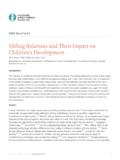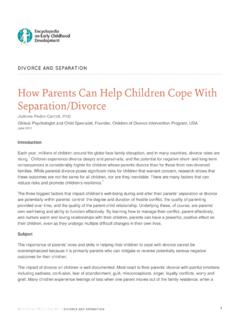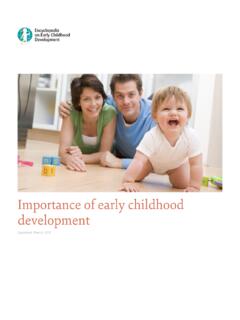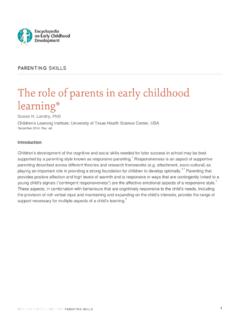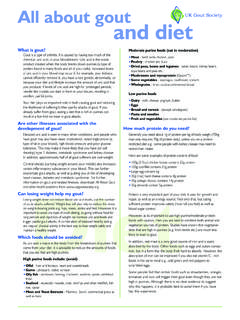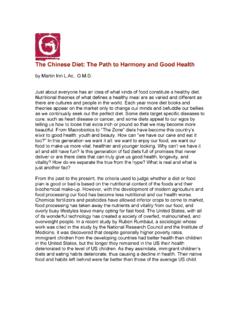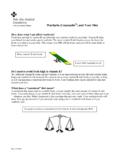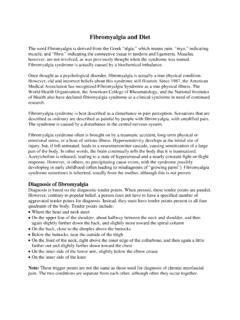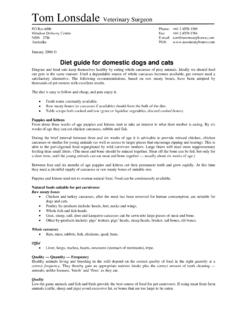Transcription of Eyes on Eating behaviours
1 Eating behavioursEyes onA recipe for healthy Eating habits When children are introduced to fruits and vegetables early in life, they are more likely to appreciate these nutritious foods when they are older. Eating behaviours 2008 - 2013 CEECD / SKC-ECDWhat do we know?n Newborns depend entirely on adults to be fed. As their motor skills develop, they gradually learn to eat on their Feeding problems are one of the most common developmental difficulties in healthy children and affect approximately 25% to 50% of children under two years of age. n The most common forms of feeding problems include an exaggerated or insufficient food intake, unhealthy diet or strange food preference. n Most problems are mild and short-lived (for example, skipped meals) but roughly 1% to 2% of feeding problems become chronic and can lead to malnutrition. n Several factors contribute to feeding problems, including genetic predispositions, physiology, temperament and environmental Most feeding problems occur when the child is introduced to new food with an unfamiliar taste, texture, smell, temperature or appearance.
2 N The diet of many toddlers consists of too few fruits and vegetables and too much high fat and sugary food. n When children systematically refuse nutritious food, parent-child relationships can become strained and mealtimes can become a major source of When children are introduced to fruits and vegetables early in life, they are more likely to appreciate these nutritious foods when they are older. n Young children tend to react negatively to parents who pressure them to change their unwanted feeding habits, this may contribute to feeding Children who watch a lot of television tend to view fast food more positively, and are more likely to have an unhealthy diet because of exposure to food advertisement. n Persistent feeding problems in young children can be improved through individualized pediatric treatment which can have a positive effect on physical and mental health.. promoting a positive meal-time your child s behaviour while the amount of time your child watches recipe for healthy Eating habits 2008 - 2013 CEECD / SKC-ECDn Provide a calm and stress-free environment to your child during meals by avoiding distractions (for example, other ongoing activities or television).
3 N Give your child enough time to eat (more than 10 minutes) but keep the duration of the meal fairly short (less than 20-30 minutes).n Eat together and engage in positive interactions with other family Provide age-appropriate equipment that facilitates self-feeding behaviours (small utensils, high-chair, bib).n Learn to recognize your child s hunger and satiety cues. n During meals, let your child express when, how much and how fast feeding should occur. n Facilitate your child s liking for a new food by pairing it with one that he already likes until it becomes familiar. n Eat healthy nutritious food, such as fruits and vegetables, to model a balanced diet and reduce unhealthy feeding habits. n Encourage your child to eat slowly by putting his utensils down after each bite. n Discourage any TV watching if your child is under 2, and limit it to 1-2 hours of high quality shows daily if your child is over 2. n Limit your child s exposure to fast food commercials, especially in the early years.
4 N Talk to your child about the content of food advertisement and lay down rules about food intake. n Encourage your child s participation in physical Seek professional help if your child s weight worries attention can be done?InformationThis information sheet is a publication of the Centre of Excellence for Early Childhood Development (CEECD) and the Strategic Knowledge Cluster on Early Child Development (SKC-ECD). These organizations identify and summarize the best scientific work on early childhood development. They disseminate this knowledge to a variety of audiences in formats and languages adapted to their a more in-depth understanding of Eating behaviours , consult our synthesis and experts articles on this topic in the Encyclopedia on Early Childhood Development, available free of charge at organizations financially support the CEECD and the SKC-ECD, including the Social Sciences and Humanities Research Council of Canada, Universit Laval, and private foundations.
5 The views expressed herein do not necessarily represent the official policies of these are grateful to the Fondation Lucie et Andr Chagnon for its financial contribution to produce this information sheet and to The Lawson Foundation for its financial support of this revised of Excellence for Early Childhood Development Strategic Knowledge Cluster on Early Child DevelopmentUniversit de Montr al3050, douard-Montpetit Blvd., Box 6128, succursale Centre-villeMontreal, Quebec H3C 3J7 Telephone: , extension 2541 Fax: : and this document, the masculine form is used merely to simplify the text. No discrimination is : Val rie BellCollaborators: Myles Faith Marie-Pierre Gosselin Kristell Le MartretCopy editor: Lana CrossmanGraphic design: DesJardins Conception Graphique Inc.
